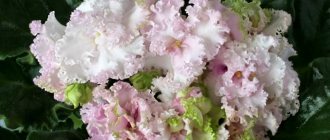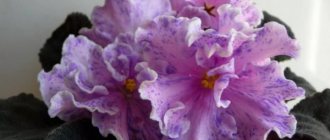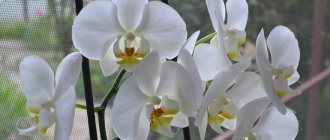The delicate and unpretentious Uzambara violet, having appeared at European flower exhibitions at the end of the 19th century, instantly attracted the attention of flower growers and gave rise to the undying interest of breeders of the Old and New Worlds in transforming its varietal qualities.
Over the years, a huge number of varieties and hybrids of the original tropical plant , and American breeders played a significant role in this.
In the middle of the last century , violet appeared in the collections of Soviet flower growers; domestic amateur violet growers actively participated in the process of its cultivation and made an invaluable contribution to improving the decorative appearance of the charming African guest.
The varieties of violets bred all over the world are conventionally divided into classic ones, found in most gardeners ’ collections, and new ones, recently introduced for sale and in particular demand.
The number of new products is constantly increasing, and previous popular varieties are becoming classics.
At the same time, good-quality classic varieties of violets gradually lose their relevance , being preserved only by the keepers of the variety and its true connoisseurs, and become retro varieties.
They may not be inferior to new products in terms of varietal characteristics and decorativeness, but they are not fashionable breeding objects.
Next, we will show you retro varieties with names and photos of domestic and foreign selection, which are still deservedly popular among violet growers.
Retro varieties of violets
According to an unspoken rule, all varieties of foreign selection obtained in the last century are completely conditionally classified as retro varieties.
IMPORTANT! Domestic varietal violets are classified as retro if they were bred before 1990. Starting from this border, for inexplicable reasons, violets acquire a decorative appearance and a modern perception that differs from retro varieties.
In the Soviet Union, Saintpaulia first appeared in Leningrad - in the Botanical Garden associated with the State University. The first specimens of violets were brought there and its director D.M. Zalessky . The breeding developments of this specialist include the magnificent varieties “Blue Danube” and “Light and Shadow”.
Boris Mikhailovich Makuni , who devoted forty years of his life to delicate violets and created more than 300 of their varieties, is unconditionally recognized as a luminary in the domestic selection of Saintpaulia In order not to divide the breeding line of the Makuni spouses (Boris Mikhailovich worked on varieties together with his wife Tatyana Nikolaevna), who created new Saintpaulias until 2002, all their varieties are considered a retro category.
Boris and Tatyana Makuni.
At the same time as the Master, many domestic breeding enthusiasts worked on the decorative appearance of violets. All of their varieties, created from the late 60s to 19990 and preserved in the collections of flower growers, belong to retro violets.
The reasons for this name
In Soviet times, only passionate non-professional flower growers . They did not know how to keep records and describe the varieties obtained, and did not think about creating catalogs and classifiers.
In this regard , many developments disappeared without a trace, and varieties were preserved in minimal quantities . It is for this reason that their violets are classified as retro.
ATTENTION! In addition, all antiques, household items and decorations that rarely appear in everyday life and carry some historical or material value fall under the term “retro”. This category also includes violet varieties bred from the last century.
Top varieties of domestic and foreign selection
Domestic selection
In the second half of the 20th century, a whole galaxy of passionate flower growers and self-taught breeders worked on the creation of new varieties of Saintpaulia.
Their names are unknown to a wide circle of violet lovers, but without their dedicated work, the emergence of new modern varieties of this marvelous plant would be difficult. Among them are:
- D.M. Zalessky;
- Makuni spouses;
- V.N. Kolesova;
- S.A. Aksyonova;
- L.V. Radin;
- V.A. Mikheeva;
- I.D. Lowbrow;
- S.I. Prilutskaya and many, many others.
“Beloved Daughter” (B.M. Makuni)
Saintpaulia type standard . Above a dense rosette of slightly wavy leaf blades of a dark green shade, a cloud of lavender color is formed from large corollas of simple fullness.
The petals have a wavy outline outlined in dark purple.
The peculiarity of the violet is the lightening of the color of its flowers as they open.
“Sweetie” (B.M. Makuni)
“Sweetie” is a representative of the Pink Series. Violet standard type.
The rosette with a neat outline consists of leathery, slightly long leaves of a dark tone with a marsh tint. The edge of the sheet is wavy, the reverse side is illuminated in red.
Flowering is cap, almost all year round. The corollas are pink carnations with a greenish fringe on each petal.
“Lilac Fog” (B.M. Makuni)
Standard type. Violet leaves of a dark shade with a rounded-toothed edge form a symmetrical rosette of dense fullness.
The voluminous cap is formed from wavy-corrugated terry-type corollas, colored with transitions of different tones of lilac.
The peculiarity is a very long period of preparation for flowering.
“Solveig’s Song” (B.M. Makuni)
"Solveig's Song" represents the author's Blue Series, being the best in the line . Standard.
An evenly filled, compact rosette is formed by rounded leaves the color of summer grass. Strong flower stalks support magnificent large corollas of a semi-double appearance with a wave along the edges of the petals.
Coloring - shimmering blue tones.
“Blue Danube” (D.M. Zalessky)
One of the first varieties of domestic selection. Standard type.
The neat rosette consists of rounded-toothed leaves with wavy edges, painted in the tone of dark green with an emerald vein. Corollas of simple fullness with a slightly wavy outline.
The buds are painted in a delicate tone of bluish-lilac color.
“Orchid” (V.A. Mikheev)
Based on the type of flower color, Saintpaulia is classified as a two-color violet.
The leaves are greenish-marsh in color with lighter veining and have a rounded shape with a slight point.
The simple-looking corollas are painted with shimmering lilac colors. Along the contour of the flower there is a white edging, turning into a clear pattern on the upper petals.
“Mazepa” (L.V. Radina)
The violet has a somewhat loose rosette due to the elongated leaf petioles. The leaf blades are rounded and light green in color.
The corollas are large in size, terry full.
The peculiarity of the violet is the change in the color of the bud : from a marble pattern in white and lilac tones to a dark lilac color.
“Dark Cherry Shawl” (I.D. Low-bow)
Standard type variety. The rosette is formed dense, with a symmetrical contour .
The leaves have a quilted structure, dark green color and a round configuration with a slight nose.
Flowering in a cap form. The corollas are laid in large sizes, with increased terry, a juicy shade of ripe cherries.
“Miss Moscow” (I.D. Nizkous)
Saintpaulia standard type . With a compact structure, an even rosette of dark green color is assembled from rounded leaf plates with a quilted structure on elongated petioles.
Flowering occurs with the formation of large corollas of terry fullness with waviness at the ends of the petals. The buds are painted with an intense shade of thick pink , reaching a ruby color.
“Rose in the Dust” (S.I. Prilutskaya)
Violet standard type. The medium-sized rosette consists of small-diameter, rounded, wavy-toothed leaf plates the color of lush grass.
It blooms with large terry-type corollas , each petal of which bends in waves. The coloring is distinguished by gentle transitions from white to shades of lilac of varying intensity.
Foreign selection
Flower growers in European countries and America began their developments much earlier than Soviet specialists; the history of their selection is rich in successful discoveries and solutions.
In these countries, entire schools of violet breeding have been established, where they learned in time to classify and describe new varieties.
Good to know! This made it possible to preserve retro violets in a larger volume, indicating the authors and year of creation.
White Madonna (J. Eyerdom) 1953
“White Madonna” was for a long time almost the only variety of violet in the USSR .
An even standard rosette, wavy-jagged leaves of a dark tone, large, terry-type snow-white corollas.
Delft Imperial (J. Eyerdom) – 1962
A classic of breeding developments, a standard type variety.
Symmetrical rosette, dark green leaves with a sharp-toothed edge on light petioles, deep blue corollas with terry fullness .
Neptune (Armacost & Royston) – 1935
Standard with oval-pointed leaves of a lush green color and strong veining. The flowers are simple in appearance , painted in a delicate lilac color with a transition to a thicker shade closer to the center.
The variety is not far removed from natural species.
French Lilac (J. Swift) – 1976
Large standard. The leaves are dark in color with sharp teeth along the edge.
The corollas are terry type, lilac-bell-shaped in color with a lighter edge along the contour of the petals.
Lilian Jarrett (F. Tinari) – 1961
Rounded leaf plates with a pointed end, the color of lush green.
It blooms with double-type corollas in delicate shades of pink.
Rules of care
The requirements for keeping them at home and the basic rules of care are practically no different from the standard recommendations for all Saintpaulias.
Accommodation
It is best if the pots of violets are placed on western or eastern window sills; northern windowsills are also suitable. Plants need to be protected from drafts and direct sunlight.
The optimal lighting mode is 10-14 hours a day, air temperature +18…24 ℃. “Scythian Gold” loves cool temperatures (at 18-20 degrees) - this way the color of the petals is better revealed, and the plant itself will look fresher.
Planting and transplanting
For planting, use small containers (7-9 cm). The main rule that is followed when selecting a pot for violets: its diameter should be three times smaller than the size of the rosette.
It is recommended to plant the plant in specialized peat soil. If possible, it is good to add moss (sphagnum), which has antiseptic properties and provides the acidity Saintpaulias need. For looseness, add perlite or vermiculite. 1/4-1/5 of the pot is filled with a layer of drainage: usually for these purposes, expanded clay of medium or fine fraction is taken.
Plants are replanted 1-2 times a year (spring or autumn)
Watering and fertilizing
Water the violets as the soil dries with warm, settled water. Do this along the walls of the pot or in a tray so that the roots do not rot. Watering should be moderate.
Excess moisture and acidification of the soil can cause the formation of translucent spots on the leaves. This problem is usually solved by pouring a weak, slightly pink solution of potassium permanganate, reducing watering, or, if that doesn’t help, completely replacing the soil.
The leaves are protected from the ingress of water and fertilizer solutions, which are applied during irrigation every two weeks, strictly observing the dosage specified in the instructions for the drug.
Quarantine and prevention
When purchasing new copies, do not rush to add them to existing ones: you need to withstand quarantine.
If a thorough examination after quarantine reveals no diseases, the newcomer pests can be added to the rest of the violets
Experts recommend regularly, at least once a week, carrying out a preventive examination in order to promptly identify diseases (powdery mildew), the appearance of pests (aphids, mealybugs, thrips, sciarids), and yellowing of leaves. If a problem is detected, the diseased plant is isolated and treated.
Original retro varieties of Saintpaulia
Among the entire variety of violets of the retro group, you can choose the most outstanding varieties for the collection based on various distinctive features:
- according to the color of the corollas - “Echo of the Carnival” (S.I. Prilutskaya);
- according to the shape of the flower - “Lituanica” (F.K. Butene) - the corollas resemble rose flowers in a reduced size;
- according to the doubleness of the flowers and the splendor of the cap - “Your Majesty” (B.M. Makuni);
- by leaf color - “Black Cat” (N.N. Shiryaeva) - variegated violet.
Description of the plant
We summarize the species and varietal characteristics in the table:
| Options | Characteristic |
| Family | Gesneriaceae |
| Genus | Saintpolia |
| Variety | "LE-Gold of the Scythians" |
| Form | herbaceous plant |
| Life cycle | perennial |
| Purpose | Decorative flowering. Indoor floriculture |
| Reproduction | Vegetative (cuttings), generative (seeds) |
| Leaf arrangement | Socket |
| Socket diameter | 20-40 cm (usually 30 cm) |
| The escape | Shortened |
| Root system | fibrous, underdeveloped |
| Attaching a leaf to a stem | Chereshkovoye |
| Sheet type | Simple |
| Leaf blade shape | Elongated, with a heart-shaped base |
| Shape of leaf blade edge | Wavy (scalloped) |
| Leaf color | Medium green |
| Flower shape | Terry star |
| Dimensions | Large, up to 4-5 cm |
| Petal coloring | White-yellow with pink border |
| Flowering duration | 1.5-2 months, 3 times a year |
E. A. Lebetskaya, the author of the variety, describes it as follows: “large double white-yellow stars with corrugated petals and a pink uneven border. The socket is neat and even. The foliage is slightly wavy and medium green.”
Densely double flowers, thanks to their fringed edge and harmonious transition of shades, create the effect of marshmallow tenderness
Separately, it is necessary to say about flowering. It lasts 45-60 days, followed by an equally long rest period. Thus, it turns out that the violet can delight with its spectacular flowers three times a year.
A peculiarity of the variety is that the yellow color does not always appear completely. It is quite possible that Saintpaulia will show itself only by the third flowering. Also, when the bud opens, you can initially detect not the varietal color, but a predominance of pink or white tones.
In the photo - violet “Gold of the Scythians” at the peak of its flowering











